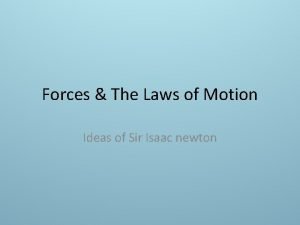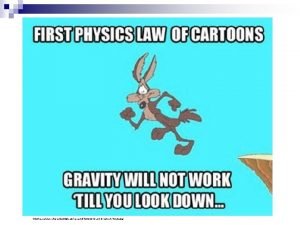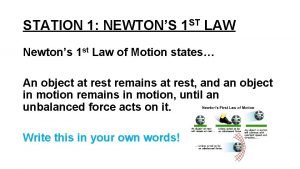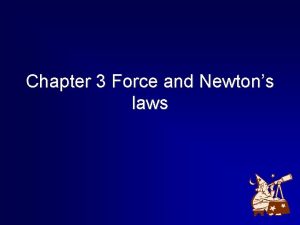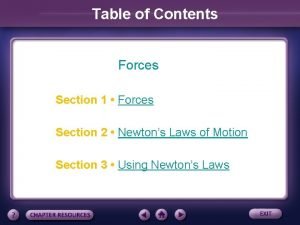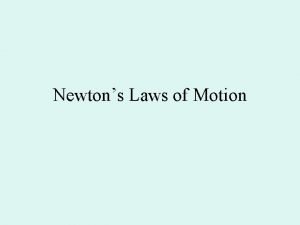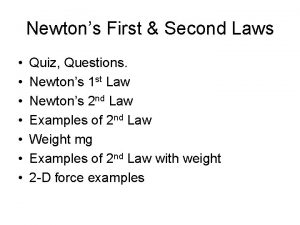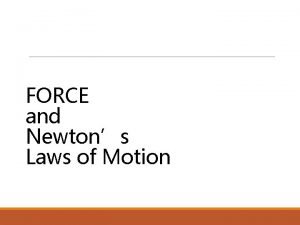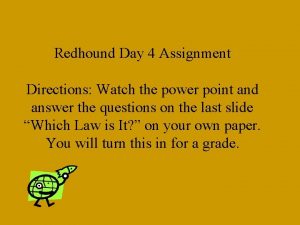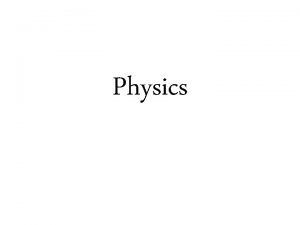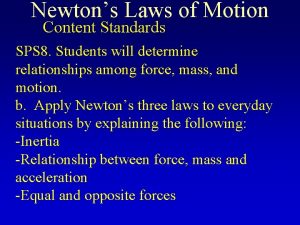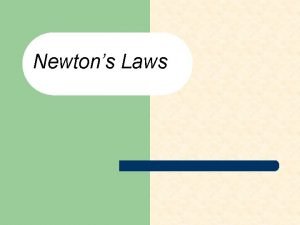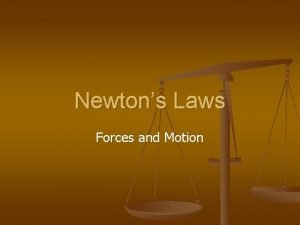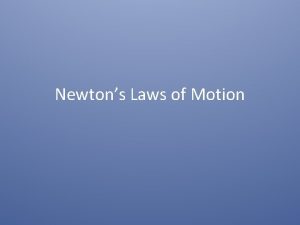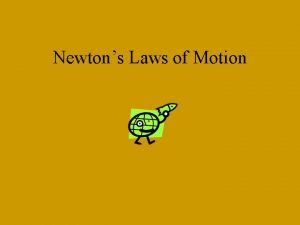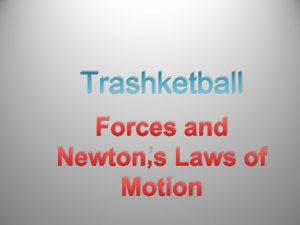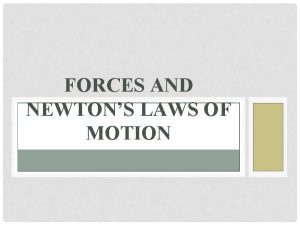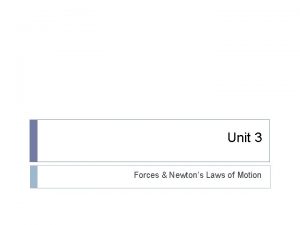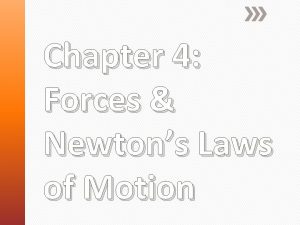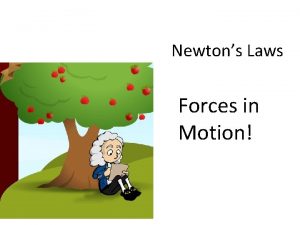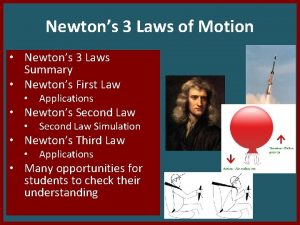FORCES AND NEWTONS LAWS OF MOTION Newtons First





















- Slides: 21

FORCES AND NEWTON’S LAWS OF MOTION

Newton’s First Law An object at rest will remain at rest and an object in motion will remain in motion unless acted upon by an outside force Net force is the vector sum of the forces acting on an object If Net Forces = Zero. Object is in Equilibrium

Inertia • The natural tendency of an object to remain at rest or in motion at a constant speed along a straight line • The mass of an object is a quantitative measure of inertia SI unit of Inertia and mass: kilogram (kg)

Newton’s Second Law of Motion If a net force is acting upon an object, the sum of the forces acting on the object is equal to the mass of the object times its acceleration ΣFnet = F 1 + F 2 + F 3…= ma Fnet = ma

Example 1: A 900 kg car accelerates from rest to 25 m/s in 6 s. What is the net force acting on the car? SI unit of force = 1 Newton = 1 kg∙m/s 2

ΣF = ma ΣFx = max ΣFy = may Example 2: wooden block F 1 = 80 N 30 o 20 kg F 2 = 60 N Find the magnitude and Direction of the block’s accel. Force x comp y comp F 1 -80 N 0 N F 2 (cos 30 o)(60 N) (sin 30 o)(60 N) ΣFx= -28. 04 N ΣFy = -30 N -28. 04 N = 20 kg*ax -30 N = 20 kg*ay

Example 3: F 1 = 28 N 25 o F 2 = 10 N Force F 1 F 2 x comp y comp

Example 4: one force acting on an object a = 4. 0 m/s 2 straight down F 1 = 147 N a = 4. 0 m/s 2 Force F 1 F 2 What are the x and y components of the second force? x comp 147 N F 2 x y comp 0 N F 2 y ΣFx = 147 N + F 2 x ΣFy = 0 + F 2 y = may ax = 0 ΣFy = F 2 y = may ΣFx = 0 = 147 N + F 2 x ΣFy = 63 kg ∙ -4. 0 m/s 2 F 2 x = -147 N F 2 y = -252 N

Newton’s Third Law If Object A exerts a force on Object B, then Object B exerts a force on Object A. These forces are equal in magnitude but opposite in direction. FAB A B FAB = -FBA

Example 5: a skater pushing against a wall A key to the correct application of the third law is that the forces are exerted on different objects. Make sure you don’t use them as if they were acting on the same object.

Identifying Forces Non-contact Forces Gravity Magnetism electric Contact Forces Push Pull

Apparent Weight • The force that the object exerts on the scale with which it is in contact • Two forces acting W=mg Normal force (FN) ΣFy = +FN – mg = ma

Apparent Weight • If acceleration is 0 m/s 2, Fy = +FN – mg = ma FN = mg + ma Apparent True weight • If acceleration is upward, apparent weight is greater than true weight Fy = +FN – mg = ma FN = mg + ma

Apparent Weight • If acceleration is downward, apparent weight is less than true weight Fy = +FN – mg = ma FN = -ma + mg • If acceleration is equal to gravity (free fall), apparent weight is 0 Fy = +FN – mg = ma FN – mg = -ma FN = 0

Example 11: 735 N man in an elevator (75 kg) Acceleration = 0 ΣFy = FN – mg = ma 735 N – (75 kg)(9. 8 m/s 2) = 0 735 N = 735 N Acceleration = 3. 0 m/s 2 upward ΣFy = FN – mg = (75 kg)(3. 0 m/s 2) FN -735 N = 225 N FN = 960 N

Acceleration = 2. 5 m/s 2 downward ΣFy = FN – mg = ma FN – (75 kg)(9. 8 m/s 2) = (75 kg)(-2. 5 m/s 2) FN – 735 N = -187. 5 N FN = 547. 5 N Acceleration = 9. 8 m/s 2 ΣFy = FN – mg = ma FN – 735 N = (75 kg)(-9. 8 m/s 2) FN = 0


Example 12: a neck in traction T F m 1 Both act on 1 st vertebrae Dr. wants 34 N to be F What is m 1? ΣFx = F – T F=T T = mg F/g = m 34 N / 9. 8 m/s 2 = 3. 5 kg

Example 13: a foot in traction ΣFy = T 1 sin 35 – T 2 sin 35 = 0 ΣFx = T 1 cos 35 + T 2 cos 35 - F = 0 T 1 = T 2 = T solve for F T 1 35 o T 2 F T 1 + T 2 = R R = 2 Tcos 35 o R is determined 2. 2 kg mass F = 2 T cos 35 o = 2 mg cos 35 o 2. 2 kg 2(2. 2 kg)(9. 8 m/s 2) cos 35 o = 35 N

Example 14: pulling a boat Find the sum of the two vectors FAx = FA cos 45 o = (40. 0 N)(0. 707) = 28. 3 N FAy = FA sin 45 o = (40. 0 N)(0. 707) = 28. 3 N FBx = FB cos 37 o = (30. 0 N)(0. 799) =24. 0 N FBy = FB sin 37 o = -(30. 0 N)(0. 602) = -18. 1 N FRx = FAx + FBx = 28. 3 N + 24. 0 N = 52. 3 N FRy = FAy + FBy = 28. 3 N -18. 1 N = 10. 2 N Then use Pythagorean theorem and tan-1

 Colin skateboards down the sidewalk
Colin skateboards down the sidewalk 3 newton's laws
3 newton's laws Newtons 3 laws of motion
Newtons 3 laws of motion Newtons laws of motion
Newtons laws of motion Derek leaves his physics book on top of a drafting table
Derek leaves his physics book on top of a drafting table Newtons first law of motion meme
Newtons first law of motion meme First law of motion
First law of motion Newtons laws
Newtons laws Problem 3
Problem 3 What are newton's 3 laws
What are newton's 3 laws Newtons laws of gravity
Newtons laws of gravity Section 3 using newtons law
Section 3 using newtons law Section 1 forces
Section 1 forces Elevator bank
Elevator bank What does f=ma mean
What does f=ma mean Newtons 3 laws quiz
Newtons 3 laws quiz Newtons laws definitions
Newtons laws definitions Motion examples in everyday life
Motion examples in everyday life Newtons laws
Newtons laws Newtons law
Newtons law Newton's law of motion
Newton's law of motion When the pellet fired into the spiral tube
When the pellet fired into the spiral tube




